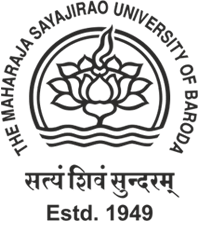Origin and History:

The idea of establishing a University at Baroda had engaged the attention of the Government of the former State of Baroda and its educational advisors long before the question of regional universities and decentralization, reorganization and reconditioning of higher education to suit the cultural educational needs of areas had taken root in the country. The concept was first visualized by Dr. Jackson, when, as Principal of the Baroda College in the 1908, he advocated the establishment of a Science Institute at Baroda on an improved and independent basis. It was a consistent policy of the Government of Baroda to subject its educational system to periodical inquiries of an exploratory nature by educational experts of international fame, because of which the first Commission was appointed in 1909. The principal recommendation of that Commission was to expand the activities of the Baroda College by establishing additional chairs in new branches of knowledge. As a result of this policy of chalking out untrodden paths in higher education and thereby evolving a university atmosphere in Baroda, chairs of Comparative Region and Household Science were instituted. Prof. Widgery and Mrs. Strong were appointed to hold these chairs.
In 1916, the educational policy of the State was again reviewed. As a part of this inquiry, one of the members of the Commission, Shri S. V. Mukerjea, prepared minutes of recommendations and in his note, he advocated the establishment of a University at Baroda. In 1919 the matter was brought to the forefront by the appointment of yet another Committee consisting of the late Principal Clarke, Prof. Widgery and Shri N. K. Dixit, the then Educational Commissioner of the State. The Committee drew up an elaborate report in favor of civic University at Baroda. Thereafter, Prof. P. Sheshadri of the Benares Hindu University was requested to lay out a scheme for a University at Baroda. Prof. Widgery also submitted a scheme for a State University on the lines of the smaller German Universities. During this period, Her Highness Shrimant Maharani Chimnabai Saheb, the Maharani Gaekwad of Baroda, offered a princely donation for running a Women's University at Baroda. But as Sir Manubhai Mehta, the then Dewan of Baroda, pointed out in one of his speeches,
"The time was not ripe then for idea to germinate."
The Rules and Regulations:
The university has its origins in the Baroda College, established in 1881 by Baroda State. The main building, which houses the Faculty of Arts, was designed by Robert Fellowes Chisholm in Indo-Saracenic architecture style, in a fusion of Indian and Byzantine arches and domes in brick and polychromed stone. The main dome on the convocation hall was modelled after the great dome of the Gol Gumbaz in Bijapur. Pratap Singh Gaekwad of Baroda (1908–1968) (the last Maharaja of the erstwhile Baroda State) founded The Maharaja Sayajirao University of Baroda in 1949 on the wishes of his grandfather, Maharaja Sayajirao Gaekwad III (1863–1939), and settled the Sir Sayajirao Diamond jubilee and Memorial Trust , which exists to date, catering to the education and other needs of the people of the former Baroda State.
The development of the University may be divided into two phases:
| Phase | College Name | Since |
| 1st Phase | Baroda College | 1881 to 1949 |
| 2nd Phase | The Maharaja Sayajirao University of Baroda | 1949 Onwards |

